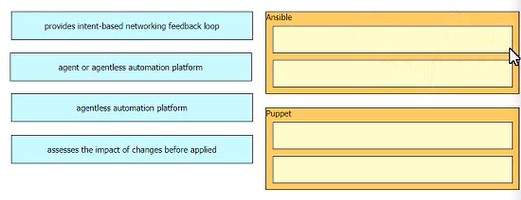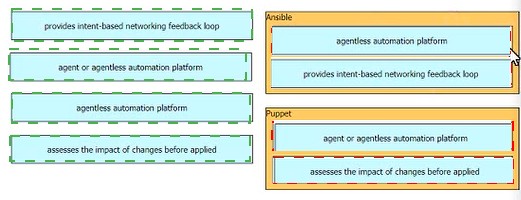- (Topic 2)
What does the LAP send when multiple WLCs respond to the CISCO_CAPWAP- CONTROLLER.localdomain hostname during the CAPWAP discovery and join process?
Correct Answer:
D
The AP will attempt to resolve the DNS name CISCO-CAPWAP- CONTROLLER.localdomain. When the AP is able to resolve this name to one or more IP addresses, the AP sends a unicast CAPWAP Discovery Message to the resolved IP address(es). Each WLC that receives the CAPWAP Discovery Request Message replies with a unicast CAPWAP Discovery Response to the AP.
Reference: https://www.cisco.com/c/en/us/support/docs/wireless/4400-series-wireless-lan-controllers/107606-dns-wlc-config.html
- (Topic 4)
Refer to the exhibit.
The OSPF neighborship fails between two routers. What is the cause of this issue?
Correct Answer:
C
cisco_R2(config-subif)#do debug ip osp adj OSPF adjacency debugging is on
cisco_R2(config-subif)#ip mtu 1111 <<<<<<<<<<<<<<<< cisco_R2(config-subif)#
cisco_R2(config-subif)# cisco_R2(config-subif)#do clear ip ospf
!!!debug shows this: cisco_R2(config-subif)#
*Dec 23 13:02:27.164: OSPF-1 ADJ Et0/0.10: Rcv DBD from 6.6.6.6 seq 0x19FD opt 0x52
flag 0x7 len 32 mtu 1500 state EXSTART <<<<<<<<<<<<<
*Dec 23 13:02:27.164: OSPF-1 ADJ Et0/0.10: Nbr 6.6.6.6 has larger interface MTU
<<<<<<<<<
*Dec 23 13:02:27.164: OSPF-1 ADJ Et0/0.10: Rcv DBD from 6.6.6.6 seq 0x26B opt 0x52
flag 0x2 len 112 mtu 1500 state EXSTART
*Dec 23 13:02:27.164: OSPF-1 ADJ Et0/0.10: Nbr 6.6.6.6 has larger interface MTU
*Dec 23 13:02:27.395: OSPF-1 ADJ Et0/0.10: Rcv DBD from 6.6.6.6 seq 0x26B opt 0x52
flag 0x2 len 112 mtu 1500 state EXSTART
- (Topic 4)
Which activity requires access to Cisco DNA Center CLI?
Correct Answer:
D
DRAG DROP - (Topic 3)
Drag and drop the automation characteristics from the left onto the appropriate tools on the right.
Solution:
Does this meet the goal?
Correct Answer:
A
- (Topic 2)
Which feature does Cisco TrustSec use to provide scalable, secure communication throughout a network?
Correct Answer:
B
Cisco TrustSec uses tags to represent logical group privilege. This tag, called a Security Group Tag (SGT), is used in access policies. The SGT is understood and is used to enforce traffic by Cisco
switches, routers and firewalls . Cisco TrustSec is defined in three phases: classification, propagation and enforcement.
When users and devices connect to a network, the network assigns a specific security group. This
process is called classification. Classification can be based on the results of the authentication
or by associating the SGT with an IP, VLAN, or port-profile (-> Answer 'security group tag ACL assigned to each port on a switch' and answer 'security group tag number assigned to each
user on a switch' are not correct as they say “assigned … on a switch” only. Answer 'security group
tag ACL assigned to each router on a network' is not correct either as it says “assigned to each
router”).